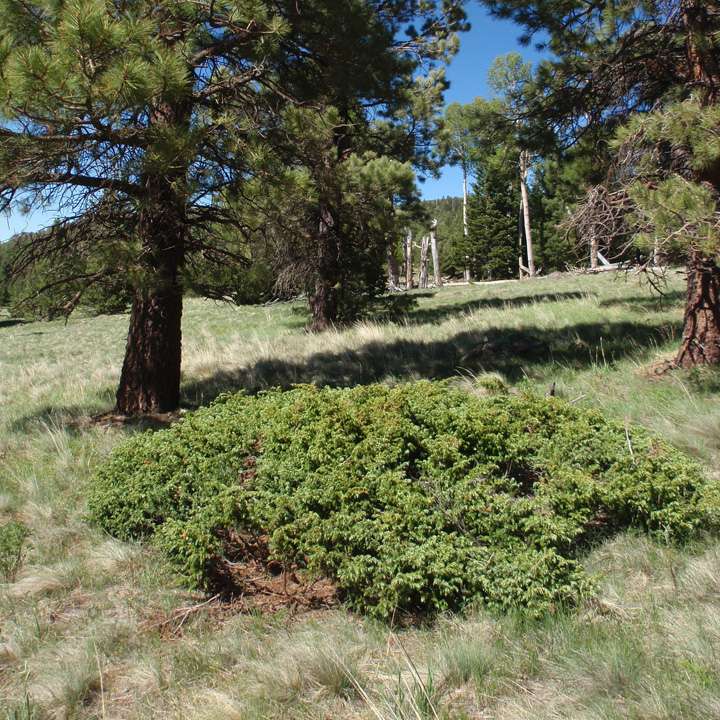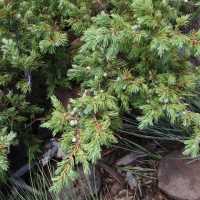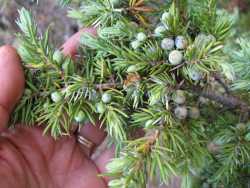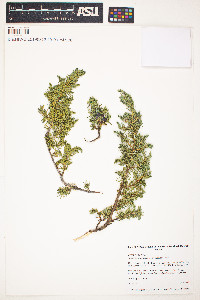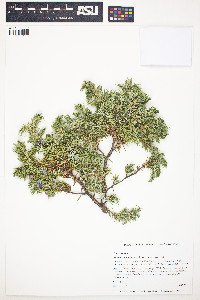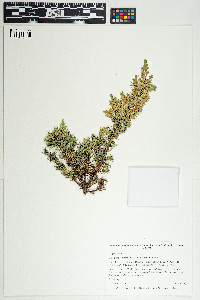|
|
|
|
Family: Cupressaceae
common juniper
[Juniperus canadensis Lodd. ex Burgsd., moreJuniperus communis subsp. depressa (Pursh) Franco, Juniperus depressa (Pursh) Raf.] |
Shrubs prostrate or low with ascending branchlet tips (occasionally spreading shrubs to 3 m, rarely small trees to 10 m). Leaves upturned, to 15 ´ 1.6 mm, rarely spreading, linear, glaucous stomatal band about as wide as each green marginal band, apex acute and mucronate to acuminate. Seed cones 6--9 mm, shorter than leaves. 2 n = 22. Rocky soil, slopes, and summits; 0--2800 m; Alta., B.C., Man., N.B., Nfld., N.W.T., N.S., Ont., P.E.I., Que., Sask., Yukon; Alaska, Ariz., Calif., Colo., Conn., Ga., Idaho, Ill., Ind., Maine, Mass., Mich., Minn., Mont., Nev., N.H., N.Mex., N.Y., N.C., N.Dak., Ohio, Oreg., Pa., R.I., S.C., S.Dak., Utah, Vt., Va., Wash., Wis., Wyo. In the flora, larger individuals of this variety (to 10 m) have been misidentified as var. communis .
PLANT: prostrate. LEAVES: to 1.6 mm wide, the glaucous band on upper surface about as wide as both green marginal bands. NOTES: See also parent taxon. Rocky or wooded slopes; boreal forest and woodland: Apache, Coconino, Gila, Greenlee, and Navajo cos.; 2100-3650 m (6900-12000 ft); Apr-May; boreal regions of U.S.; Canada. REFERENCES: Bartel, Jim A. 1994. Cupressaceae. J. Ariz. - Nev. Acad. Sci. Volume 27, 195-200. Shrub 0.5 - 2 m tall Leaves: in whorls of three, needle-like, often with a white line above, shiny dark green beneath, 1 - 1.8 cm long, tip sharply pointed, almost perpendicular to the stem, holding for 3 years. Leaves turn yellow to brownish green in winter. Bark: dark reddish brown, peeling in long, loose scales. Twigs: shiny greenish yellow, becoming reddish brown. Form: trailing along the ground with erect tips (decumbent) to form circular patches; a dwarfed form of <i>J. communis</i>. Cones: unisexual, with separate pollen and seed cones produced on different plants (dioecious). Pollen cones: 4 - 5 mm long, widest at base. Seed cones: almost spherical with three to four scales; scales fusing to become berry-like, blue to almost black with a waxy whitish coating (glaucous), 6 - 13 mm in diameter, nearly spherical, each containing one to three egg-shaped seeds; seeds 2 - 3 mm long, typically three-angled, take three years to mature. Pollination occurs from late April to early June. Similar species: The typical variety of Juniperus communis has a conical to open growth habit. Habitat and ecology: Old foredunes and clayey slopes near Lake Michigan, sand dunes farther from the lake, and in areas with dry, rocky soil. Occurence in the Chicago region: native Notes: Juniperus communis var. depressa is the most common form of J. communis in the Chicago Region. Etymology: Juniperus is the Latin name for juniper. Communis comes from the Latin word for common. Depressa comes from the Latin word for low, referring to its growth habit. Author: The Morton Arboretum |


